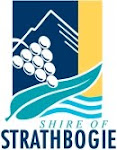Walking tours and site visits
Groups can arrange to visit the retrofitted community buildings to see the works described on this blog. We also sometimes conduct village walking tours, which include the retrofitted community buildings, wood-fired oven, community forest, energy efficient homes, and Murrnong Permaculture Farm.
To discuss a possible group visit, contact David Arnold 03 5798 1679, arnold.vt@gmail.com, or Robin Landvogt, 03 5798 1735, rplandvogt@gmail.com [Tours of Murrnong Permaculture Farm are held more often, contact David directly about these.] Below are the details of a previous village walking tour.
Walking Tour, 11am to 3pm, Sunday August 21st 2011
The tour advertised as part of the Festival of Design on Sunday 24th July has booked out. This event on Sunday 21st August has the same format. Bookings/ enquiries to arnold.vt@gmail.com, ph 03 5798 1679
Come for a tour of Violet Town sustainability initiatives with local permaculture designer and teacher David Arnold, and see how much even a small rural community can achieve in just a few years.
Visit the energy efficiency retrofit of the community buildings, a volunteer-driven creek restoration project, two energy efficient houses, the Violet Town Community Forest, and Murrnong Permaculture Farm, all by easy walking from the centre of town and the train station. For each element of the tour, David, and the householders visited, will discuss how they interact with their house/ building/ forest/farm to achieve energy efficiency, productivity, and a high standard of amenity. A lunch of local produce is included with the tour.
To live more sustainably we need to observe and interact with our environment. We need to actively manage our own houses, our shared public buildings, our public open spaces, our food supply, and in Violet Town they are even providing for their own forestry products.
The design strategies discussed all require some active management, are evolving and changing over time, and are responsive to changing circumstances.
Tour starts at Violet Town Community Complex, 37 Cowslip St, Violet Town, 11am.
For train travellers we will fit in with the Vline service that arrives at 11.09, and have you back in time to catch the 2.41.
$30/ adults, $15/ children Bookings/ enquiries to arnold.vt@gmail.com, 03 5798 1679
Presented by Violet Town Action Group.












